Back to Journals » Clinical, Cosmetic and Investigational Dentistry » Volume 13
Evaluation of ICCMS versus CAMBRA Caries Risk Assessment Models Acquisition on Treatment Plan in Young Adult Population: A Randomized Clinical Trial
Authors Khallaf YS , Hafez S , Shaalan OO
Received 6 May 2021
Accepted for publication 22 June 2021
Published 15 July 2021 Volume 2021:13 Pages 293—304
DOI https://doi.org/10.2147/CCIDE.S318313
Checked for plagiarism Yes
Review by Single anonymous peer review
Peer reviewer comments 4
Editor who approved publication: Professor Christopher E. Okunseri
Yomna Sayed Khallaf, Shereen Hafez, Omar Osama Shaalan
Conservative Dentistry Department, Faculty of Dentistry, Cairo University, Cairo, Egypt
Correspondence: Yomna Sayed Khallaf
Conservative Dentistry Department, Faculty of Dentistry, Cairo University, 11 Al Saraya, Elmanyal, Cairo, Egypt
Tel +20 2 23634965
Fax +20 2 23646375
Email [email protected]
Purpose: To evaluate the difference between ICCMS and CAMBRA models on treatment plan of young adults.
Settings and Design: A total of 104 young adult patients were randomly divided into two groups, either ICCMS or CAMBRA.
Patients and Methods: Patients were examined according to the criteria of the ICDAS-II and caries risk was analyzed according to CAMBRA and divided into two equal groups according to treatment protocol. Caries incidence was assessed according to ICDAS-II criteria after 6 and 12 months. Statistical analysis used Chi-square test. A value of P ≤ 0.05 was considered statistically significant. Relative risk (RR) was used to determine the clinical significance.
Results: The current study has revealed no statistically significant difference between both caries risk assessment models tested at baseline (P = 0.317), 6 months (P = 0.164) and 1 year (P = 0.287). Intra-group assessment of CAMBRA group showed a statistically significant difference in ICDAS scores (P = 0.002) after 12 months in high- and moderate-risk groups while low-risk group did not show statistically significant difference in ICDAS scores between different follow-up periods (P = 0.593) and (P = 1.000), respectively. ICCMS groups did not show statistically significant differences in any group along follow-up periods.
Conclusion: ICCMS and CAMBRA were equivalent in preventing new decay. The ICCMS treatment plan is a safe approach and its preventive products are available over the counter. However, it is more complicated than CAMBRA. While CAMBRA is simpler, it is less comprehensive, some of its products are not available over the counter worldwide (e.g. Duraphat 5000 ppm) and some of them may be accompanied by several side effects (e.g. chlorhexidine mouthwash), which may weaken its management protocol.
Keywords: caries risk assessment, ICDAS II, preventive approach, comprehensive system, fluoride
Introduction
Dental caries is a major oral problem that affects about 60–90% of children worldwide and is estimated to reach up to 100% of the adult population.1 The traditional approach is based on surgical intervention (i.e. drill and fill) which treats the manifestation of the disease (tooth decay) rather than the cause of the disease, bacterial infection. The end result of this surgical approach to caries management is the eventual loss of teeth.2 Minimally invasive dentistry (MID) is a philosophy of caries management focusing on risk assessment of individual patients to determine disease indicators, risk factors and protective factors.3,4. The possibility of the presence of a certain number of caries lesions over time can be defined as caries risk.5
Caries management by risk assessment (CAMBRA) utilizes caries risk assessment in which dental caries is treated as a bacterial disease process following the medical model to prevent future cavitation before its occurrence.6 CAMBRA is a validated system with 47.62% sensitivity and 80% specificity and accurately detects patients at high and extreme caries risk.7 Caries incidence appears in low, moderate, high or extreme high caries risk.8
Evaluation of different systems for caries risk assessment indicates that there is no agreement in dentistry on standards. This has led the developers of the systems to write a comprehensive care plan, the International Caries Classification and Management System (ICCMS™).2 ICCMS™ is a comprehensive system that include all recent information which describes the beginning and progression of dental caries and provides proper diagnosis, prevention and restoration only if indicated. It has well-developed and standard protocols for the application of a new model of caries management.9
The International Caries Detection and Assessment System (ICDAS) presents a new standard for the measurement of dental caries, with its development based on a systematic review.10 Currently the ICDAS II system is applied in dental education, clinical applications, research and epidemiological studies.11 Studies have revealed good inter- and intra-examiner reproducibility and the accuracy of ICDAS II in detecting occlusal caries.12 Linking between ICCMS™ and ICDAS facilitates the creation of tooth and patient information for dentists to manage dental caries in clinical practice.13 There is only a case report that evaluates ICCMS14 and there are no clinical trials that have evaluated the ICCMS™ system so far. This randomized, controlled clinical trial was performed to evaluate this system and to test the null hypothesis that ICCMS™ will have the same clinical performance as CAMBRA.
Patients and Methods
Study Settings
Procedures of this study were performed following the ethical criteria of Research Ethics Committee of Faculty of Dentistry, Cairo University with reference number (18-9-45), accordant with the Declaration of Helsinki and its later modifications.15 All procedures were explained to participants and written informed consents were obtained before the beginning of the trial. A protocol was registered in (www.clinicaltrials.gov) database with ID (NCT03668093).
Study Design
This clinical trial was a double-blinded (participants and assessors), parallel-arm clinical study. The main researcher was responsible for activities associated with explaining and performing the procedures to participants. Follow-up period was selected to be 12 months since risk category is changed for better or worse over 1–2 years, also for the early detection of carious lesions.16
Eligibility Criteria
Dental students with age range from 17–22 years, unlikely to move from the area within 1 year for any reason, were included for high anticipated retention rates, while students with systemic conditions, who use medication that might affect the oral flora or salivary flow, drug or alcohol addicts, students who missed a screening visit without cancellation or rescheduling, students with periodontal disease requiring surgery or chemotherapeutic agents, patients sensitive to chlorhexidine, and students with orthodontic braces were excluded.
Sample Size Calculation
Sample size calculation was achieved using PS: Power and Sample Size Calculation Software Version 3.1.2 (Vanderbilt University, Nashville, Tennessee, USA). Based on previous studies,17 the success rate in the treatment plan was 77% in caries management by risk assessment, and the success rate in intervention arm is 97%. Using power 80% and 5% significance level 43 patients were needed in each group. This number was increased to a sample size of 52 to compensate for losses during follow-up.
Recruitment
Dental students from the Faculty of Dentistry, Cairo University were enrolled from which eligible patients were recruited to fulfill the eligibility criteria one week before intervention (Figure 1). In total 104 dental students, 52 participants in each group, were divided according to caries risk into 3 sub-groups: for intervention (ICCMS) group: Low (n = 17), Moderate (n = 17), High (n = 18), while in comparator (CAMBRA) group: Low (n = 18), Moderate (n = 17), High (n = 17).
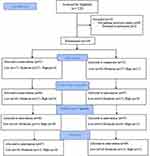 |
Figure 1 Consort flow diagram showing the process of case selection.Notes: Adapted from: Schulz KF, Altman DG, Moher D, for the CONSORT Group (2010) CONSORT 2010 Statement: Updated Guidelines for Reporting Parallel Group Randomised Trials. PLoS Med. 7(3):e1000251. Copyright: © 2010 Schulz et al. Creative Commons Attribution License.42 |
Sequence generation was accomplished using simple randomization. Simple randomization was done by generating numbers from 1–52 using a randomization website.18 Each generated random number represented assigning either intervention or comparator, then the operator picked between numbers in an opaque sealed envelope which contained the randomization code. The randomization code was not released until the patient is a member of the trial.
Blinding
The operator was not blinded to model of caries risk assessment due to the difference in each protocol, which prohibited blinding of the operator; however, participants and assessors were blinded to the model of caries risk assessment.
Diagnosis
Personal information was collected and recorded by the operator who performed a visual examination under optimal lighting conditions with a plain mirror and tactile examination with CPITN probe “ball-ended” rather than a sharp explorer that was used gently across the surface to confirm the loss of surface integrity. Then a trained examiner recorded scores of each lesion according to the ICDAS II scoring system; ICDAS II scores are composed of two numbers for detecting primary carious lesions. The first number is associated with the restoration and the second number classifies the carious lesion in a range from 0 to 6. Clinical photographs of each ICDAS score recorded in this clinical trial are presented in (Table 1) (Figure 2A–G). The examiners were trained to accurately use the caries scoring criteria and protocol at home and during training and calibration meetings by reviewing the training material presentation from the ICCMS website19 illustrating the caries scoring/evaluation criteria, then they did full mouth examination for 10 patients, an intra-examiner and inter-examiner agreement at least 85% was necessary before beginning the evaluation. Examiners evaluated all carious lesions once and independently. When disagreement happened during evaluations they had to reach consensus before the participant was dismissed.20
 |
Table 1 Scores of ICDAS Classification of Dental Caries |
Caries Risk Assessment
Caries risk assessment: CAMBRA chart was used for control and intervention groups for standardization. It included the assessment interview of patients, clinical examination, salivary and microbial tests (Figure 3).
 |
Figure 3 CAMBRA chart. Notes: Reproduced from: Hurlbutt M. CAMBRA: best Practices in Dental Caries Management. Ada Cerp. 2011;96.21 Copyright © 2003, 2010, 2011, 2019, 2020, 2021 The Regents of The University of California. CAMBRA® is a trademark of The Regents of the University of California. Creative Commons 4.0 International license (CC BY-NC-ND 4.0; https://creativecommons.org/licenses/by-nc-nd/4.0/legalcode). |
The Caries Management by Risk Assessment (CAMBRA) chart21 consists of three parts.
The first section is “disease indicators” that includes: - any visible cavitation or radiographic lesion either occlusal or proximal, any white spot lesion indicated by dryness of the tooth surface by air/water tip or any restoration in the past 3 years. Any “YES” marked in this place the patient at high risk.
The second section is about “the risk factors” that the patient has, such as high or medium S. mutans and lactobacilli, heavy plaque accumulation which indicates bad oral hygiene, dietary habits such as frequency of cariogenic snacks between meals (beverages and soft drinks using cariogenic sweetener is considered as snack), tooth anatomy and deep fissures, any reducing factor/drug for salivary flow, inadequate salivary flow, if the patient has any orthodontic appliance which can impair achievement of good oral hygiene, also any gingival recession which can increase plaque adherence by exposing the roots. Circling “YES” for any items in this column placed the patient at moderate risk.
The third section is “protective factors” such as living in a fluoridated community which was always included as Egypt is one of the countries that has fluoridated tap water, daily oral hygiene measures, the patient was also asked about other oral hygiene measures such as mouthwash (fluoride/ chlorhexidine), any other protective factor such as fluoride varnish or the use of calcium phosphate paste in past 6 months, and the regular use of xylitol gum. Patients with no circled “YES” items in the first two columns are at low risk.
Salivary Flow Estimation
Salivary samples were collected past noon, post lunch; participants refrained from eating or drinking an hour prior to sample collection. Participants were seated in upright, relaxed position. They were provided with a paraffin pellet (Ivoclar-Vivadent paraffin pellets) to chew for 30 seconds and instructed to spit out the accumulated saliva or swallow it. The chewing was then continued for the next 5 minutes and saliva was collected continuously in a measuring cup.22
Estimation of Mutans Streptococci and Lactobacilli in Saliva
The saliva was transferred immediately for bacterial culture. After incubation, and counting of growing colonies, results higher than 105 CFU of MS and/or LB indicate a high risk for future caries disease.
Shifting the Plaque Ecology
The plaque microflora was changed by oral prophylaxis, restoration of decayed teeth and removal of non-restorable teeth, promoting oral hygiene and fluoride varnish application.
Restoration and Rehabilitation
This phase involved all restorative procedures. Fissure sealant was applied on non-carious occlusal surfaces and occlusal surfaces with incipient lesions. All existing decay was restored for enrolled participants.
Comprehensive Approach of ICCMS
There are four steps in ICCMS leading to a personalized treatment plan for each patient depending on risks and needs.14 These start by determination of caries risk by CAMBRA since ICCMS adopts the CAMBRA philosophy in risk assessment, then detection of lesions’ severity and their activity status, followed by decision making, and end by doing an appropriate tooth-preserving and patient-level prevention and control.
Each patient’s caries risk factors management plan was tailored at the individual level. A preventive plan addressing both home care and clinical approaches depends on the caries risk likelihood status of each patient and the best available evidence. ICCMSTM recommends activities, and practitioners may choose from a package of preventive interventions based on ICCMSTM guidelines Table 2.
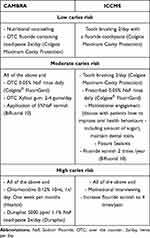 |
Table 2 Difference Between CAMBRA and ICCMS Treatment Plan |
Compliance
The researchers contacted each high caries-risk participant the week prior to a new month and reminded participants to use chlorhexidine rinse for the first week of the month (one-minute rinse, one hour after brushing teeth each evening) to avoid interaction between chlorhexidine gluconate and dentifrice ingredients.23
Assessment
At each follow-up period (6 months and 12 months), two highly qualified staff members as blinded examiners performed visual/tactile examination for all patients according to ICDASII criteria and recorded scores for each patient.
Statistical Analysis
Statistical analysis was performed using IBM SPSS Statistics Version 2.0 for Windows. Data were presented as mean, standard deviation (SD), frequencies (n) and percentages. Kolmogorov–Smirnov and Shapiro–Wilk tests were used to assess data normality of continuous data. The significance level was set at P ≤ 0.05. Mann–Whitney test was performed for intergroup comparisons and Kruskal–Wallis test followed by Wilcoxon signed-rank test/Mann–Whitney test were used for multiple comparisons. Chi-square test was used to compare frequency distribution of categorical data. Absolute risk, relative risk (the ratio of risks of the intervention group and the control group) and relative risk reduction (by subtracting RR from one) were calculated by MedCalc software and 95% confidence intervals were calculated.
Results
Of the 104 dental students, 52 participants in each group were divided according to caries risk into 3 sub-groups: for intervention (ICCMS) group: Low (n = 17), Moderate (n = 17), High (n = 18), while in comparator (CAMBRA) group: Low (n = 18), Moderate (n=17), High (n = 17). Students of both genders (64.4% females at 19–20 years old and 35.5% males at 20–21 years old) were enrolled into this trial. The results of the current study have revealed no statistically significant difference in caries incidence between CAMBRA and ICCMS groups at baseline (P = 0.317), 6 months (P = 0.164) and 1 year (P = 0.287) (Table 3). In the high caries-risk group within the CAMBRA group, there was a statistically significant difference in caries incidence at 1 year (P = 0.002), it was significantly higher than those of baseline and 6 months, which were statistically similar. Within the ICCMS group, there was no statistically significant difference in caries incidence between different follow-up periods (P=0.227; Table 4). A relative risk (risk ratio) of 4.33 was associated with ICCMS, with −3.33% relative risk reduction at 6 months. While at 1 year a relative risk of 0.46 was associated with CAMBRA, with 53% relative risk reduction (Table 5).
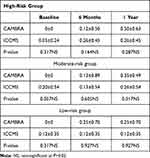 |
Table 3 Mean±SD and P-value for the Inter-Group Comparison of ICDAS Scores Between Caries Risk Assessment Models at Each Follow-Up Period in All Groups |
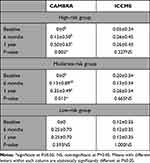 |
Table 4 Mean±SD and P-value for the Intra-Group Comparison of ICDAS Scores at Different Follow-Up Periods Within Each Caries Risk Assessment Model in all Groups |
 |
Table 5 Absolute Risk, Relative Risk (Risk Ratio) of Caries Incidence Within High Caries-Risk Group at Different Follow-Up Periods at 95% Confidence Interval |
Regarding the moderate caries-risk group within the CAMBRA group, there was a statistically significant difference in caries incidence (P = 0.013) at 1 year, ICDAS mean score was significantly higher than that of baseline. ICDAS mean score at 6 months did not differ significantly from that of baseline and 1 year. Within the ICCMS group, there was no statistically significant difference in caries incidence between different follow-up periods (P = 0.665). A relative risk of 0.46 was associated with the ICCMS group, with −1.16% relative risk reduction at 6 months. At 1 year, a relative risk of 0.74 was associated with CAMBRA, with 25% relative risk reduction (Table 5).
In contrast the low caries-risk group did not show a statistically significant difference in caries incidence within the CAMBRA and ICCMS groups between different follow-up periods at P = 0.593 and P = 1.000, respectively. Moreover, there was no difference in absolute risk (12%) between both CAMBRA and ICCMS groups at either 6 months or 1 year, with 0% relative risk reduction. Also, there was no statistically significant difference in ICDAS score distribution between CAMBRA and ICCMS in all caries risk groups with P = 0.310, P = 0.061 and P = 0.301 at baseline, 6 months and 1 year, respectively in high caries-risk group, in the moderate caries-risk group baseline (P = 0.053), 6 months (P = 0.219) and 1 year (P = 0.599), and similarly in the low caries-risk group at baseline (P = 0.302), 6 months (P = 0.368) and 1 year (P = 0.368) (Table 6).
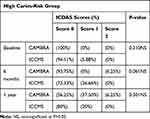 |
Table 6 Distribution of ICDAS Scores Within Each Caries Risk Assessment Model at Different Follow-Up Periods in Hign Caries Risk Group |
Discussion
The current study evaluated ICCMS and CAMBRA caries risk assessment and prevention models and the development of new decay. Altogether 104 dental students of both genders from the Faculty of Dentistry were enrolled to a randomized, controlled, double-blind clinical trial, 52 participants in each group. Selection of young adults in the age group 18–25 years was due to the importance of this age group in the study of dental health and its determinants, since it is a shift from adolescence to adulthood, a time when individuals take responsibility for their health. Also the selection of dental students was made for their expected high motivation and adherence to guidelines and follow-up visits, due to their specific knowledge about disease prevention and better oral hygiene compared with general population. Furthermore, students in dental faculties may have high socioeconomic status, which in turn may lead to better oral health (Drachev et al.).24 This study was not designed to test a certain product, but rather to decide which therapeutic management of dental caries based on risk would display lower caries incidence.
Results of this trial revealed that regarding high and moderate caries-risk CAMBRA groups, there was a statistically significant difference in ICDAS scores (caries incidence). At 1 year, ICDAS mean score was significantly higher than those of baseline and 6 months, which were statistically similar. There was no statistically significant difference in ICDAS scores between different follow-up periods. This might be attributed to lack of patient compliance or improper use of preventive therapy, whether in amount or periodicity or due to underestimation of caries risk.
This was in agreement with Chaffee et al.25 They found that caries incidence was increased between high-risk and extreme-risk patients. This may be due to the majority of high-risk patients not having been treated with any form of caries preventive agent. It was unknown whether this failure in use of preventive therapies was on the part of doctors, patients, or both. This could be a result of misjudgement of caries risk (Chaffee et al.).26
Similar findings were described by another study for Chaffee et al.27 comparing between individuals receiving preventive agents twice or more and others who did not receive preventive agents. It was found that there was no statistically significant difference in the incidence of new decay; this finding indicates that in high-risk populations, preventive agents might be most valuable for reducing disease severity rather than preventing caries completely. They refer the lack of preventive effect associated with only a single treatment to poor adherence of patients. In contrast, patients in multiple-visits groups showed compliance to use at-home and in-office therapy and concluded that regularly receiving caries preventive agents can reduce tooth decay in high-risk populations.
Doméjean et al.8 found caries incidence occurred in low, moderate and high caries-risk groups and explained that the majority of the patients did not receive the preventive therapy due to patient resistance. This may be because of providers’ omission i.e. they did not explain the importance of the prevention therapy or patients’ reasons, either their financial situation or compliance; these finding also were reported in several articles supporting compliance as a great factor in caries prevention. e.g. Sbaraini et al.28
However, this finding was in disagreement with Featherstone et al.29 They found that a combined antibacterial and fluoride treatment resulted in no significant differences in Δ DMFS between control and intervention groups and attributed this to the use of an antimicrobial rinse with fluoride that reduced the bacterial challenge, without a significant increase in mean salivary fluoride concentration in those participants in the intervention group who were provided with the NaF mouthwash. This may be due to either they were not totally compliant with fluoride rinsing or that the daily 0.05% sodium fluoride mouthwash was not a sufficient dose for this high caries-risk group and they recommend use of 5000 ppm fluoride toothpaste twice a day or fluoride varnish application. The same was established in Cheng et al.30 There was no statistically significant difference in bacterial challenge or salivary fluoride level separately but the overall risk was significantly reduced at one year in intervention group; this may be due to limited sample size or participants were provided by 1100 ppm fluoride toothpaste rather than high concentrated fluoride toothpaste.
Moreover, Rechmann et al.31 found that the percentage of caries incidence were lower in the intervention group than the control group and attributed that to preventive caries therapy which reduced caries risk level more effectively than the traditional care and to high compliance of participants to dentists’ recommendations.
However, in general there were no statistically significant differences between ICDAS scores of CAMBRA and ICCMS groups at baseline, 6 months and 1 year in low, moderate and high caries-risk groups.
The size of the intervention treatment effect versus a control is often reported as a relative risk (RR) or relative risk reduction (RRR) (Table 5). In the current study the results may be attributed to participants not attaining a high level of compliance immediately after receiving recommendations and guidelines toward preventive practice in ICCMS group while in the CAMBRA group participants did not maintain a high level of compliance across the follow-up period.
This was in agreement with the only case report evaluating ICCMS14 perceiving that positive health outcomes can be achieved by preventing and controlling caries by engaging the patient as a health partner with practice to modify behaviours to control the disease process and to create together a shared, personalized plan of care.
In spite of differences in treatment protocol there is a resemblance in results that may be due to the high motivation from patients, but high absolute and relative risk after 1 year in the CAMBRA group in spite of using high concentration fluoridated toothpaste and antimicrobial mouth rinse may be due to a lack of compliance of patients, using improper amount of toothpaste, insufficient sample size or the follow-up period was not enough to decide which protocol should be accredited.
Also, caries incidence may be due to underestimation of the caries risk, consistent with Rechmann and Featherstone32 and Young et al.33 Overrating the caries risk may lead to over treatment and it is not a cost-effective solution, while underrating the caries risk might have serious consequences. Another study discovered that caries incidence occurred after 16 months in more than 20% of patients who were assessed as low caries risk at baseline. Probably, the majority of these patients were wrongly assessed as low caries risk.8
As mentioned before the present study was not conducted to evaluate the effect of certain products such as chlorhexidine antimicrobial mouthwash or fluoridated toothpaste-mouth rinse but to evaluate the systems as a whole, since none of the meta-analyses of chlorhexidine in any method of administration showed a significant reduction of the incidence, stopped, or reversed caries, for children and adults at high risk.34 It has however been shown to reduce Streptococcus mutans in the oral cavity temporarily.35
Regular use of relatively low concentration fluoride toothpaste or mouthwash results in constant high fluoride concentrations in saliva.36 Consistent with the latest systematic review, high concentration fluoride toothpaste with 5000 ppm would significantly improve salivary concentration of fluoride, modify caries risk, and prevent mineral loss,37 but a critical point affecting Duraphat toothpaste efficiency, is that the small opening of the tube may have resulted in a smaller amount of applied toothpaste. Other factors that affect fluoridated products’ effectiveness beside fluoride concentration are amount of toothpaste and post-brushing water rinsing that may reduce fluoride concentration in saliva 2.4 times after using 5000 ppm toothpaste.38
Although the selection of dental students has many benefits, such as high levels of awareness, in that students seemed to understand the details of important concepts of proper oral hygiene, in agreement with Nassar,39 on other hand it has drawbacks since the dental environment stress appears to affect oral health passively, which is shown by higher dental caries among dental students with severe dental environment stress affecting the normal level of salivary flow rate.40
Finally, because of the complexity of dental caries, a genetic factor on caries liability has a moderately strong evidence; for example genes related to enamel formation, physical characteristics of saliva and dietary desire, also the onset and progression of dental caries may be affected by micronutrient insufficiencies.41
In the current study it was observed that general oral health was improved in both systems, although the development of new carious lesions may be due to previously mentioned causes in the Discussion.
Conclusions
Attributable to the multifactorial nature of dental caries there are multiple confounders that can affect treatment plans of caries management. Within the limitations of the current study the following conclusions could be delivered:
- ICCMS and CAMBRA were equivalent in preventing new decay.
- Moderate and high caries-risk populations using (CAMBRA) prevention model developed new carious lesions at 1-year follow-up.
- No difference in new lesion development in all caries risk populations using the ICCMS prevention model.
- Participants did not attain high level of compliance immediately after receiving recommendations and guidelines toward preventive practice in the ICCMS group while in the CAMBRA group participants did not maintain high level of compliance across follow-up period.
- ICCMS treatment plan is safe and its preventive products are available over the counter. However, it is more complicated than CAMBRA; while CAMBRA is more simplified it is less comprehensive, and some of its products are not available over the counter worldwide (e.g. Duraphat 5000 ppm) and some of them may be accompanied by several side effects (e.g. chlorhexidine mouthwash) that may weaken its management protocol.
- Unexpectedly, dental students did not show proper adherence to recommendations.
- A stressful dental environment negatively affects oral health.
Clinical Recommendations
- This study is the first randomized clinical trial evaluating ICCMS, so further clinical trials are necessary to confirm the present finding.
- Creation of a new form of caries risk assessment based on modification of both systems to produce a comprehensive simplified system supported by software and depending on available preventive products.
- Standardization of caries risk assessment model is essential when comparing different preventive protocols.
Abbreviations
CPITN probe, The Community Periodontal Index of Treatment Need probe; ICDAS II, The international caries detection and assessment system; CFU, Colony-Forming Unit; LB, Lactobacillus; MS, Streptococcus mutans; DMFS, Decayed, missed, filled surface.
Data Sharing Statement
All patients’ records, photographs and data of materials are available from the corresponding author [Yomna Sayed Khallaf], and will be shared upon request via Email: [email protected].
Disclosure
The authors report no conflicts of interest in this work.
References
1. Kassebaum NJ, Bernabé E, Dahiya M, Bhandari B, Murray CJL, Marcenes W. Global burden of untreated caries: a systematic review and metaregression. J Dental Res. 2015:1–9. DOI:10.1177/0022034515573272
2. Ismail AI, Tellez M, Pitts NB, et al. Caries management pathways preserve dental tissues and promote oral health. Community Dent Oral Epidemiol. 2013;41(1):12–40. doi:10.1111/cdoe.12024
3. Brostek AM, Walsh LJ. Minimal intervention dentistry in general practice. Oral Health Dent Manag. 2014;13(2):285–294.
4. Maheswari SU, Raja J, Kumar A, Seelan RG. Caries management by risk assessment: a review on current strategies for caries prevention and management. J Pharm Bioallied Sci. 2015;7(Suppl 2):S320–4. doi:10.4103/0975-7406.163436
5. Zukanović A. Caries risk assessment models in caries prediction. Acta Med Acad. 2013;42(2):198–208. doi:10.5644/ama2006-124.87
6. Featherstone JDB, Domejean-Orliaguet S, Jenson L, Wolff M, Young DA. Caries risk assessment in practice for age 6 through adult. J Calif Dent Assoc. 2007;35(10);46.
7. Sudhir KM, Kanupuru K, Fareed N, Mahesh P, Vandana K, Chaitra NT. CAMBRA as a Tool for Caries Risk Prediction Among 12- to 13-year-old Institutionalised Children – a Longitudinal Follow-up Study. Oral Health & Preventive Dentistry. 2016;14(4):355–362. doi:10.3290/j.ohpd.a35621
8. Doméjean S, White JM, Featherstone JDB. Validation of the CDA CAMBRA caries risk assessment--a six-year retrospective study. J Calif Dent Assoc. 2011;39(10):709–715.
9. Ismail AI, Pitts NB, Tellez M, et al. The International Caries Classification and Management System (ICCMSTM) An Example of a Caries Management Pathway. BMC Oral Health. 2015;15(1):S9. doi:10.1186/1472-6831-15-S1-S9
10. Ismail AI. Visual and Visuo-tactile. J Dental Res. 2004;56–66.
11. Chu C, Lo ECM. Current and Future Research in Diagnostic Criteria. Oral Health Prev Dent. 2013;11:181. doi:10.3290/j.ohpd.a29365
12. Mb D, Ja R, Hug I, Rcl C, Reproducibility LA. Reproducibility and accuracy of the ICDAS-II for occlusal caries detection. Community Dentistry Oral Epidemiol. 2009;37:399. doi:10.1111/j.1600-0528.2009.00487.x
13. Pitts NB, Ismail AI, Martignon S, Ekstrand K, Douglas GVV, Longbottom C. ICCMSTM Quick Reference Guide for Practitioners and Educators. Oral Health Prev Dent. 2016;1–45.
14. Beltrán EO, Guiu L, Zarta OL, Pitts NB, Martignon S. Caries classification and management in the context of the CariesCare International (CCITM) consensus: a clinical case study. Br Dent J. 2019;227(5):363–366. doi:10.1038/s41415-019-0680-1
15. Review C, Communication S, Principles G. World medical association declaration of helsinki ethical principles for medical research involving human subjects. Bulletin World Health. 2015;2013–2016.
16. Teich ST, Demko C, Al-Rawi W, Gutberg T. Assessment of Implementation of a CAMBRA-Based Program in a Dental School Environment. J Dent Educ. 2013;77(4):438–447. doi:10.1002/j.0022-0337.2013.77.4.tb05489.x
17. Ruiz Miravet A, María J, Company M. Evaluation of caries risk in a young adult population. Med Oral Patol Oral Cir Bucal. 2007;12(1):412–418.
18. Random.org. Available from: https://www.random.org.
19. International Caries Classification and Management System (ICCMS)TM Maintaining and preserving tooth structure. Available from: https://www.iccms-web.com.
20. Rechmann P, Jue B, Santo W, Rechmann BMT, Featherstone JDB. Calibration of dentists for caries management by risk assessment research in a practice based research network - CAMBRA PBRN. BMC Oral Health. 2018;18(1):2. doi:10.1186/s12903-017-0457-3
21. Hurlbutt M. CAMBRA: best Practices in Dental Caries Management. Ada Cerp. 2011;96.
22. Gauba K, Goyal A, Mittal N. A CAMBRA Model For High Caries Risk Indian Children: a Pragmatic Comprehensive Tailored Intervention. J Clin Pediatr Dent. 2016;40(1):36–43. doi:10.17796/1053-4628-40.1.36
23. Kolahi J, Soolari DDSA. Rinsing with chlorhexidine gluconate solution after brushing and flossing teeth: a systematic review of effectiveness Rinsing with chlorhexidine gluconate solution after brushing and flossing teeth: a systematic review of effectiveness. Bulletin World Health. 2014.
24. Drachev SN, Brenn T, Trovik TA. Prevalence of and factors associated with dental anxiety among medical and dental students of the Northern State Medical University, Arkhangelsk. Int J Circumpolar Health. 2018;77(1):1454786. doi:10.1080/22423982.2018.1454786
25. Chaffee BW, Cheng J, Featherstone JDB. Baseline caries risk assessment as a predictor of caries incidence. J Dent. 2015;43(5):518–524. doi:10.1016/j.jdent.2015.02.013
26. Chaffee BW, Featherstone JDB. Long-Term Adoption of Caries Management by Risk Assessment Among Dental Students in a University Clinic. J Dent Educ. 2015;79(5):539–547. doi:10.1002/j.0022-0337.2015.79.5.tb05913.x
27. Chaffee BW, Cheng J, Featherstone JDB. Non-operative anti-caries agents and dental caries increment among adults at high caries risk: a retrospective cohort study. BMC Oral Health. 2015;15(1):1–8. doi:10.1186/s12903-015-0097-4
28. Sbaraini A, Carter SM, Evans RW, Blinkhorn A. How do dentists and their teams incorporate evidence about preventive care? An Empirical Study. 2013;41:401–414.
29. Featherstone JDB, White JM, Hoover CI, et al. A randomized clinical trial of anticaries therapies targeted according to risk assessment (caries management by risk assessment). Caries Res. 2012;46(2):118–129. doi:10.1159/000337241
30. Cheng J, Chaffee BW, Cheng NF, Gansky SA, Featherstone JDB. Understanding treatment effect mechanisms of the CAMBRA randomized trial in reducing caries increment. J Dent Res. 2015;94(1):44–51. doi:10.1177/0022034514555365
31. Rechmann P, Chaffee BW, Rechmann BMT, Featherstone JDB. Changes in Caries Risk in a Practice-Based Randomized Controlled Trial. Adv Dent Res. 2018;29(1):15–23. doi:10.1177/0022034517737022
32. Rechmann P, Featherstone JDB. Quality Assurance Study of Caries Risk Assessment Performance by Clinical Faculty Members in a School of Dentistry. Journal of Dental Education. 2014;78(9):1331–1338. doi:10.1002/j.0022-0337.2014.78.9.tb05805.x
33. Young DA, Fa BA, Rogers N, Rechmann P. The Effect of Calibration on Caries Risk Assessment Performance by Students and Clinical Faculty. Journal of Dental Education. 2017;81(6):667–674. doi:10.21815/JDE.017.013
34. Rethman MP, Beltrán-aguilar ED, Ronald J, et al. Nonfluoride caries-preventive agents. J Am Dent Assoc. 2011;142(9):1065–1071. doi:10.14219/jada.archive.2011.0329
35. Ribeiro LGM, Hashizume LN, Maltz M. The effect of different formulations of chlorhexidine in reducing levels of mutans streptococci in the oral cavity: a systematic review of the literature. J Dent. 2007;35:359–370. doi:10.1016/j.jdent.2007.01.007
36. Walsh T, Worthington HV, Glenny AM, Marinho VCC, Jeroncic A. Fluoride toothpastes of different concentrations for preventing dental caries. Cochrane Database Syst Rev. 2019;2019(3). doi:10.1002/14651858.CD007868.pub3
37. Chaudhary D, Patthi B, Singla A, et al. The anticariogenic efficacy of 5000 ppm fluoridated toothpaste: a systematic review. J Clin Diagnostic Res. 2018;12(1):ZE04–ZE10. doi:10.7860/JCDR/2017/26732.11135
38. Nordström A, Birkhed D. Preventive effect of high-fluoride dentifrice (5000 ppm) in caries-active adolescents: a 2-year clinical trial. Caries Res. 2010;44(3):323–331. doi:10.1159/000317490
39. Nassar HM. Dental caries preventive considerations: awareness of undergraduate dental students. Dent J. 2020;8(2):31. doi:10.3390/DJ8020031
40. Al-moosawi RIK, Qasim AA. Original Article The Impact of Dental Environment Stress on Dentition Status, Salivary Nitric Oxide and Flow Rate. Journal of International Society of Preventive & Community Dentistry. 2020;10(2):163–170. doi:10.4103/jispcd.JISPCD
41. Ilc C, Bouchard P, Mg C, et al. Interaction of lifestyle, behaviour or systemic diseases with dental caries and periodontal diseases: consensus report of group 2 of the joint EFP/ORCA workshop on the boundaries between caries and periodontal diseases. J Clinical Periodontol. 2017:44. doi:10.1111/jcpe.12685
42. Schulz KF, Altman DG, Moher D, for the CONSORT Group (2010) CONSORT 2010 Statement: Updated Guidelines for Reporting Parallel Group Randomised Trials. PLoS Med. 7(3):e1000251.
 © 2021 The Author(s). This work is published and licensed by Dove Medical Press Limited. The full terms of this license are available at https://www.dovepress.com/terms.php and incorporate the Creative Commons Attribution - Non Commercial (unported, v3.0) License.
By accessing the work you hereby accept the Terms. Non-commercial uses of the work are permitted without any further permission from Dove Medical Press Limited, provided the work is properly attributed. For permission for commercial use of this work, please see paragraphs 4.2 and 5 of our Terms.
© 2021 The Author(s). This work is published and licensed by Dove Medical Press Limited. The full terms of this license are available at https://www.dovepress.com/terms.php and incorporate the Creative Commons Attribution - Non Commercial (unported, v3.0) License.
By accessing the work you hereby accept the Terms. Non-commercial uses of the work are permitted without any further permission from Dove Medical Press Limited, provided the work is properly attributed. For permission for commercial use of this work, please see paragraphs 4.2 and 5 of our Terms.

